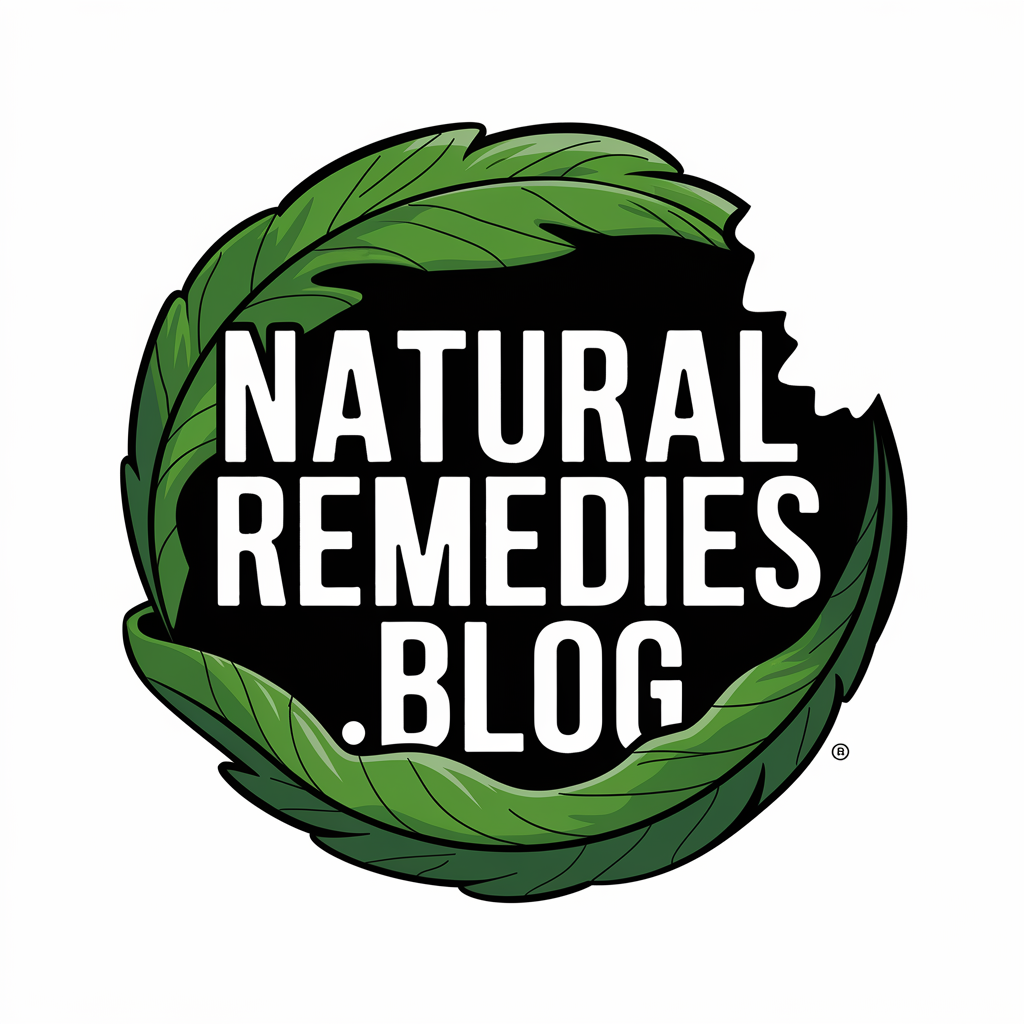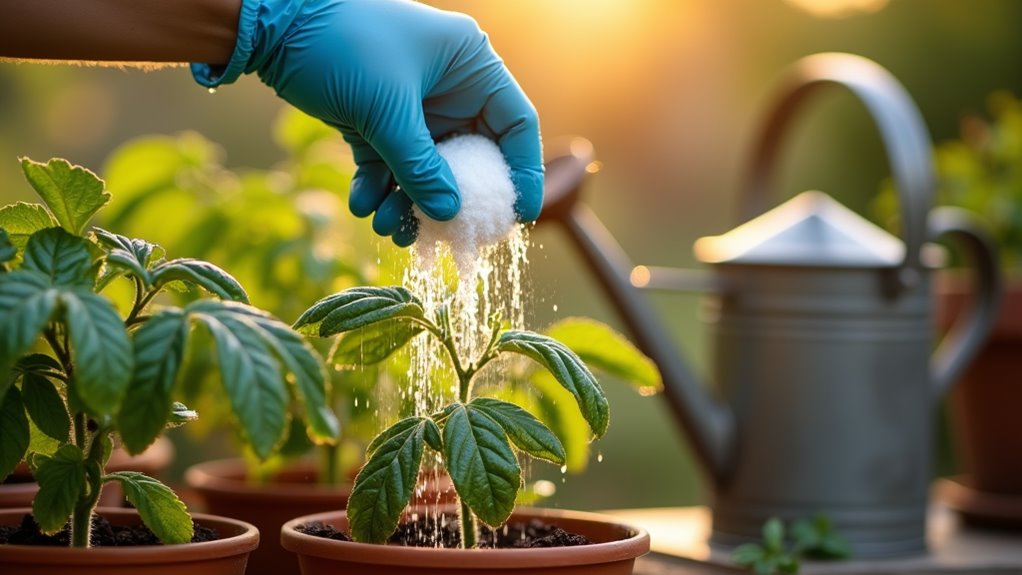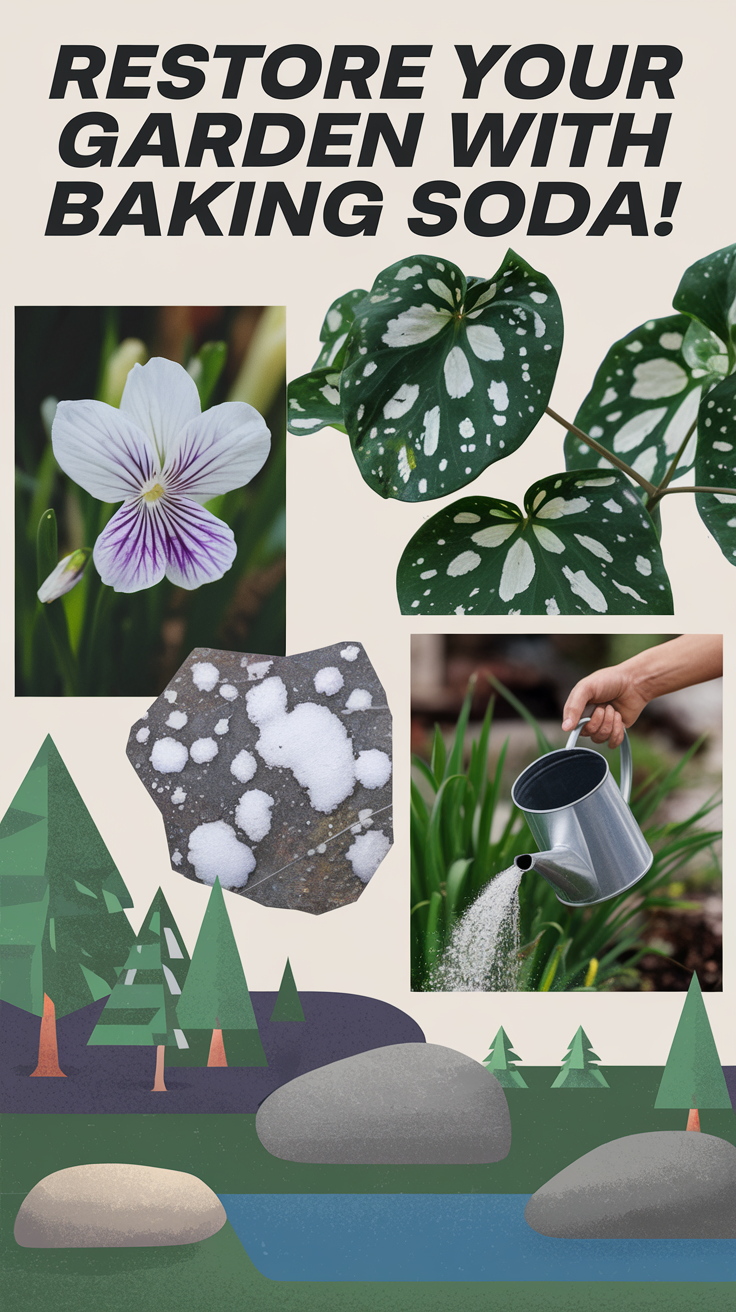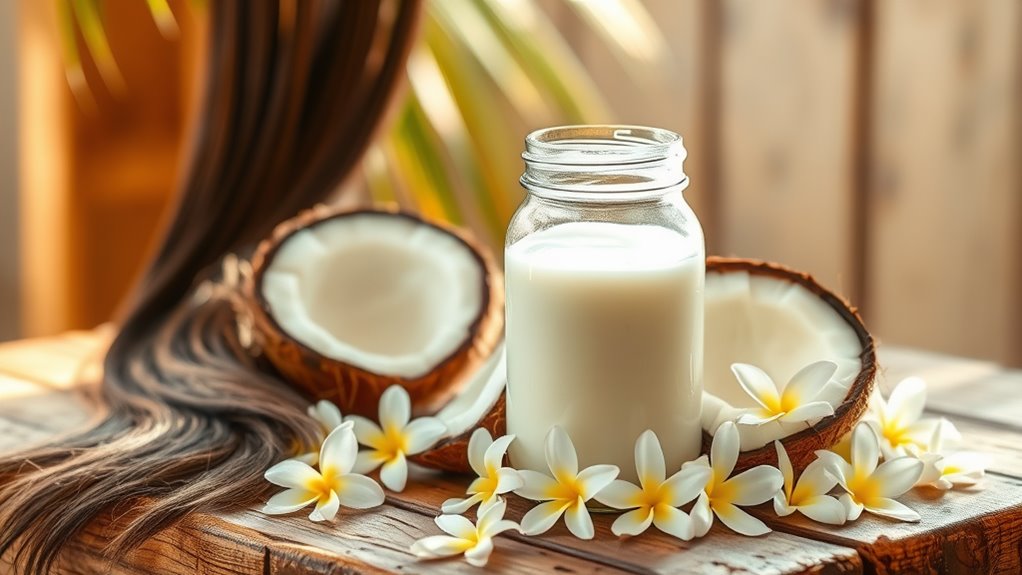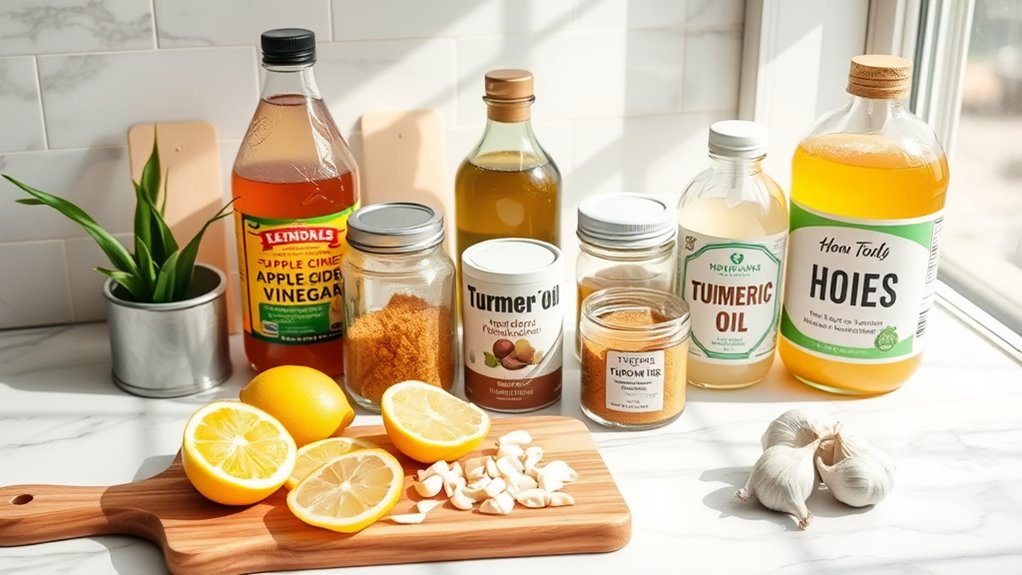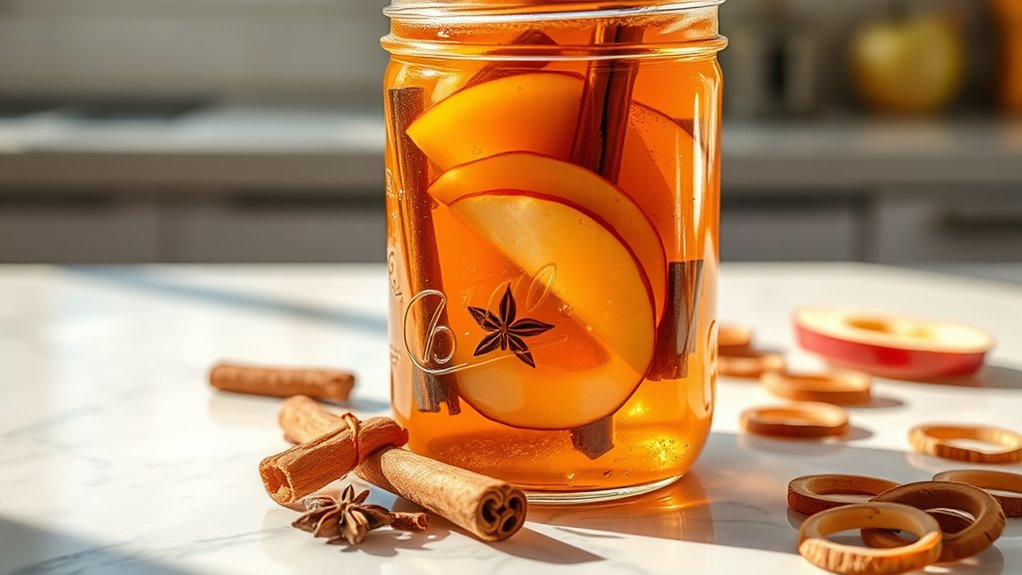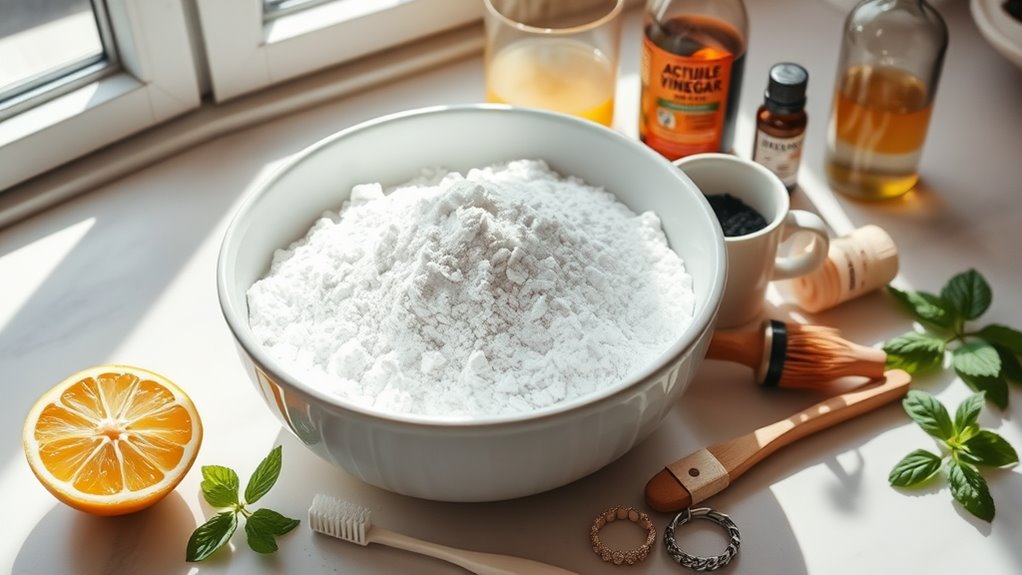Restore Your Garden With Baking Soda!
Baking soda is your eco-friendly solution for reviving garden health naturally. You’ll find this versatile powder helps adjust soil pH, prevents fungal diseases, and deters pests while keeping beneficial insects safe. To get started, mix 1 cup of baking soda with 2 gallons of water and apply it to your garden soil, keeping 6 inches away from plants. By following proper seasonal application strategies, you’ll discover how this simple household staple transforms your garden’s health.
Key Takeaways
-
Mix 1 cup of baking soda with 2 gallons of water to create a natural solution for adjusting overly acidic soil.
-
Apply baking soda solution weekly during summer months to maintain proper soil pH and deter unwanted garden pests.
-
Use baking soda as a natural fungicide to prevent and treat plant diseases without harming beneficial insects.
-
Treat yellowing leaves and stunted growth by testing soil pH and applying baking soda to restore proper nutrient absorption.
-
Apply baking soda solution during early spring and late fall, keeping 6 inches distance from plants for even coverage.
What Makes Baking Soda a Garden Essential
Baking soda’s versatility makes it an indispensable tool for gardeners looking to maintain healthy plants naturally. You’ll find this common household ingredient can transform your garden care routine with its pH-balancing properties and gentle yet effective pest control abilities.
As a natural fungicide, it helps prevent and treat common plant diseases without harsh chemicals. You can use baking soda for hydrangeas to adjust their bloom colors – adding it to the soil creates a more alkaline environment, resulting in pinker flowers.
It’s also perfect for testing your soil’s acidity levels quickly and affordably. Fellow gardeners trust baking soda because it’s environmentally friendly, readily available, and safe for beneficial insects.
It’s particularly effective at deterring destructive pests while preserving your garden’s delicate ecological balance.
Understanding Soil Ph and Plant Health
Soil pH serves as the foundation for your garden’s success, directly influencing how well plants absorb essential nutrients. When your soil’s pH is off balance, your plants can’t take up the minerals they need, even if those nutrients are present in abundance.
Most garden plants thrive in slightly acidic soil with a pH between 6.0 and 7.0. You’ll notice signs of pH problems when your plants show yellowing leaves, stunted growth, or poor flowering.
That’s where baking soda comes in – it’s a natural way to adjust overly acidic soil. By testing your soil regularly and understanding its pH needs, you’re joining countless gardeners who’ve learned to work with nature rather than against it.
Testing Your Garden’s Ph Levels
How can you determine if your garden needs a pH adjustment? The most reliable way is to conduct a soil pH test. You’ll find affordable testing kits at your local garden center or online. These kits typically include test strips or a probe that changes color based on your soil’s acidity level.
To test your soil, collect samples from different areas of your garden, about 6 inches deep. Mix these samples together, remove any debris, and follow your test kit’s instructions.
Most plants thrive in soil with a pH between 6.0 and 7.0, though some prefer more acidic or alkaline conditions. If your results show levels outside your plants’ preferred range, you’ll know it’s time to adjust your soil’s pH with amendments like baking soda for acidic soil or sulfur for alkaline soil.
Calculating the Right Amount of Baking Soda
Once you’ve determined your soil needs alkaline adjustment, calculating the correct amount of baking soda becomes your next step. For every 5 square feet of soil, you’ll need approximately 1 cup of baking soda to raise the pH by one point.
Start small and monitor the changes closely.
Before applying, mix your baking soda with water to create a solution that’s easier for your soil to absorb. You’ll want to combine 1 cup of baking soda with 2 gallons of water for ideal distribution.
Many experienced gardeners recommend splitting your application into two sessions, spaced one week apart, to prevent shocking your plants.
Remember to test your soil’s pH again after each application. It’s better to make gradual adjustments than to risk over-alkalizing your garden bed.
Best Times to Apply Baking Soda
When planning your baking soda application, early spring and late fall offer the perfect conditions for soil treatment. During these seasons, the soil temperature remains moderate, and moisture levels are typically ideal for absorption.
You’ll want to apply baking soda on a calm, dry day to prevent wind dispersal and guarantee proper soil contact.
For pest control and fungal issues, it’s best to treat your garden early in the morning while dew is still present. This allows the baking soda to stick to plant surfaces effectively.
If you’re using it to adjust soil pH, apply it 2-3 weeks before planting in spring or after harvest in fall.
Don’t apply baking soda during heavy rain periods or in intense midday sun, as this can reduce its effectiveness and potentially harm tender plants.
Step-by-Step Soil Treatment Process
Before treating your soil with baking soda, you’ll need to test its pH level using a reliable soil testing kit.
Once you’ve confirmed your soil is too acidic, mix 1 cup of baking soda with 2 gallons of water until completely dissolved.
Water your soil thoroughly with plain water first, then apply the baking soda solution evenly across the treatment area using a watering can.
Work the solution into the top 6 inches of soil with a garden fork or tiller. Let the soil rest for 24 hours before retesting the pH.
If needed, repeat the process every two weeks until you achieve the desired pH level.
Remember to monitor your plants closely during treatment, as they’ll tell you if you’re making progress through improved growth and vigor.
Hydrangea Color Enhancement Techniques
Beyond adjusting soil pH for general garden health, baking soda can specifically help you achieve stunning blue or pink hydrangea blooms.
You’ll love how easily you can transform your hydrangeas by adding baking soda to raise the soil’s pH level.
For pink blooms, sprinkle 1/2 cup of baking soda around your hydrangea’s base during the growing season.
You’ll want to work it gently into the top layer of soil and water thoroughly.
For maintaining blue flowers, skip the baking soda, as these blooms prefer acidic conditions.
Remember to test your soil’s pH before treatment, and apply the baking soda solution monthly during the growing season.
Join other successful gardeners who’ve mastered this simple technique – you’ll be amazed at how your hydrangeas respond to this natural color enhancement method.
Signs of Ph Imbalance in Plants
How can you spot pH problems in your garden before they become serious? Your plants will give you clear signals when the soil’s pH isn’t right.
Look for yellowing leaves, especially between the veins, which often indicates iron deficiency in alkaline soil. You’ll notice stunted growth and poor flowering when pH levels are off.
In acidic soil, you might see your plants developing purple-tinged leaves, particularly on the undersides.
Watch for leaves that curl inward or become brittle, as this suggests nutrient lockout from improper pH. Your plants may also show weak stems, leaf drop, or brown spots.
If you’re seeing multiple plants with similar issues, it’s time to test your soil’s pH. The sooner you identify these warning signs, the easier it’ll be to correct the problem.
Mixing Baking Soda Solutions
When preparing a baking soda solution for your garden, you’ll need to strike the right balance to avoid harming your plants. For most applications, mix 1-2 tablespoons of baking soda per gallon of water.
Here’s your go-to guide for common garden solutions:
| Purpose | Mixing Ratio |
|---|---|
| Fungal Treatment | 1 tbsp/gallon |
| pH Adjustment | 2 tbsp/gallon |
| Pest Control | 1.5 tbsp/gallon |
| Leaf Cleaning | 1 tbsp/gallon |
Always test your solution on a small area first. You’ll want to spray in the early morning or late evening when temperatures are cooler. Don’t forget to shake your mixture thoroughly before each use, as baking soda can settle at the bottom. For best results, add a few drops of liquid soap to help the solution stick to plant surfaces.
Safety Precautions During Application
Although baking soda is generally safe to use in gardens, you’ll need to take proper precautions during application to protect yourself and your plants.
Always wear gloves and a dust mask to prevent inhaling the powder, especially on windy days. Don’t apply baking soda solutions during peak sunlight hours, as this can burn your plants’ leaves.
Keep children and pets away from treated areas until the solution has dried completely. When spraying, maintain a safe distance of at least 6 inches from plant surfaces to guarantee even coverage without oversaturation.
If you’re treating edible plants, wait at least 24 hours before harvesting, and rinse produce thoroughly before consumption. Store any unused baking soda mixture in a clearly labeled container out of reach of children and pets.
Common Mistakes to Avoid
Despite baking soda’s versatility in garden care, many gardeners make critical mistakes that can harm their plants. One common error is applying too much baking soda, which can alter soil pH levels drastically.
You’ll want to avoid direct contact between baking soda and plant foliage, as this can cause leaf burn.
Don’t make the mistake of using baking soda solutions on already stressed or damaged plants, as this may worsen their condition.
Many fellow gardeners also forget to test their soil’s pH before treatment, leading to over-correction.
Remember not to apply baking soda mixtures during peak sunlight hours or in hot weather, as this can intensify any negative effects.
Finally, avoid mixing baking soda with other garden chemicals without researching compatibility first.
Seasonal Application Guidelines
Since seasons greatly impact gardening conditions, you’ll need to adjust your baking soda applications throughout the year. Your garden’s needs change as temperatures and moisture levels fluctuate, so timing is essential for ideal results.
| Season | Application Rate | Key Focus |
|---|---|---|
| Spring | Every 2 weeks | Fungal prevention |
| Summer | Weekly | pH balancing |
| Fall | Monthly | Disease control |
You’ll want to increase applications during humid periods when fungal issues are more likely to develop. In spring, focus on preventive treatments as new growth emerges. Summer requires more frequent applications to combat pest problems and maintain soil pH. During fall, reduce your applications but monitor areas near decomposing leaves where mold might grow. Winter typically doesn’t require baking soda treatments unless you’re gardening indoors.
Monitoring Plant Response
Watch your plants closely after applying baking soda to guarantee they respond positively to the treatment. Look for signs of improvement like reduced fungal spots, healthier leaf color, and stronger stems within 3-5 days.
You’ll notice your garden thriving as the natural remedy takes effect.
If you see any yellowing leaves, wilting, or leaf burn, you’ve likely used too much baking soda. Don’t worry – you can fix this by thoroughly rinsing the affected areas with clean water and reducing the concentration in your next application.
Keep a garden journal to track which plants respond best to the treatment. You’ll join countless successful gardeners who’ve mastered this eco-friendly solution by staying attentive to their plants’ needs and adjusting accordingly.
Combining With Other Natural Treatments
While baking soda works well on its own, you can enhance its effectiveness by combining it with other natural treatments.
Mix it with neem oil to create a powerful fungicide that’ll protect your plants from multiple diseases. You can also combine it with liquid soap for better leaf adhesion or add apple cider vinegar for an extra boost against powdery mildew.
For stronger pest control, blend baking soda with companion planting strategies.
Plant marigolds or nasturtiums nearby while applying your baking soda solution. You’ll also find that pairing baking soda treatments with proper mulching helps retain soil moisture and prevents fungal growth.
Many fellow gardeners have success mixing baking soda with essential oils like tea tree or lavender for added plant protection.
Long-term Garden Maintenance
To maintain a healthy garden throughout the seasons, you’ll need to establish a regular baking soda treatment schedule. Most gardeners find success by applying baking soda solutions every two weeks during growing seasons and monthly during dormant periods.
Keep a garden journal to track your applications and their effectiveness.
Monitor your soil’s pH levels regularly, as frequent baking soda use can gradually increase alkalinity. You’ll want to adjust your treatment frequency based on these readings and your plants’ response.
Store your premixed baking soda solution in a labeled spray bottle for quick access, and always clean your gardening tools after use to prevent cross-contamination between treated and untreated areas.
Join local gardening groups to share your experiences and learn from others who’ve mastered baking soda treatments in their gardens.
Troubleshooting Ph Problems
Since baking soda naturally raises pH levels, you’ll need to carefully monitor your soil for signs of excessive alkalinity.
Watch for yellowing leaves, stunted growth, or poor nutrient absorption in your plants, as these indicate pH imbalances that need attention.
Test your soil’s pH regularly with a home testing kit, and keep a log of your readings.
If you’ve added too much baking soda, you can lower the pH by incorporating sulfur, pine needles, or coffee grounds into your soil.
Remember that different plants thrive at different pH levels – what works for your tomatoes mightn’t work for your blueberries.
Join your local gardening community to share pH management experiences and learn from fellow gardeners who’ve mastered the art of soil balance in your specific climate zone.
Alternative Uses in the Garden
Beyond adjusting soil pH, baking soda serves multiple practical purposes in your garden.
You’ll find it effective as a natural fungicide to combat powdery mildew on plants like cucumbers and roses. Just mix one tablespoon with a gallon of water and spray affected leaves weekly.
You can also use baking soda to clean your gardening tools, plant containers, and birdbaths. Create a paste with water to scrub away stubborn dirt and mineral deposits.
For pest control, sprinkle it around plant bases to deter slugs and snails. It’s also great for sweetening tomatoes – just sprinkle a light dusting of baking soda around the soil of your tomato plants.
Remember to join your local gardening community to share these eco-friendly tips and learn new ones from fellow green thumbs.
Record Keeping for Success
Keeping three key garden records will maximize your baking soda applications and overall garden success. Track your garden’s pH levels, pest occurrences, and fungal outbreaks to build a thorough treatment history. You’ll quickly identify patterns and perfect your baking soda solutions.
| Record Type | What to Track |
|---|---|
| pH Levels | Weekly readings, rainfall, amendments |
| Pest Activity | Locations, types, treatment dates |
| Fungal Issues | Affected plants, humidity, spread |
Join other successful gardeners by maintaining detailed notes about your baking soda treatments. Download our companion garden journal template to seamlessly record your observations. When you document each application’s concentration and timing, you’re building a valuable reference for future growing seasons. You’ll know exactly what worked and when to apply treatments next year.
Frequently Asked Questions
How Long Does Baking Soda Remain Effective in Garden Soil?
You’ll notice baking soda’s effects in your soil for about 2-3 months. After that, it’ll naturally break down and lose potency, so you’ll need to reapply for continued benefits.
Can Baking Soda Solutions Damage Beneficial Insects in My Garden?
You’ll want to use diluted baking soda solutions carefully, as they can harm beneficial insects like ladybugs and bees. It’s best to spray early morning or evening when garden friends aren’t active.
Will Rain Wash Away the Baking Soda Treatment Immediately?
You’ll want to reapply baking soda after heavy rain, but light showers won’t completely wash it away. For best results, apply when you’re expecting a few dry days ahead.
Does Baking Soda Treatment Affect the Taste of Edible Plants?
You won’t notice any taste changes in your edible plants when using baking soda correctly. It’s a gentle, food-safe treatment that naturally breaks down, leaving your garden produce tasting fresh and natural.
Can I Use Expired Baking Soda for Garden Applications?
You can safely use expired baking soda in your garden. While it’s lost some potency for baking, it’ll still work effectively for your plants and soil treatments just like fresh baking soda.
